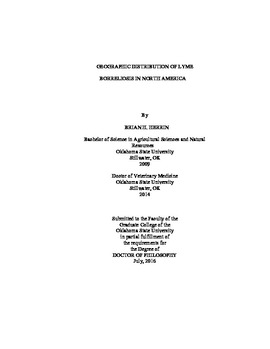| dc.description.abstract | The research presented in this dissertation was conducted using canine serology as a tool to further the characterization of Lyme endemic regions of North America. In chapter 3, targeted tick testing in southwestern Virginia was implemented to validate canine serology showing an expansion of the Lyme endemic region from the north. All 364 ticks were morphologically and molecularly identified as Ixodes scapularis, and 33% tested positive for Borrelia burgdorferi sensu stricto by PCR. Canine serology was again utilized (Chapter 4) to describe environments where dogs, and thus humans, were most likely to be exposed to B. burgdorferi around the New York City Metropolitan Area. In this study environmental and social variables were organized by county and compared to prevalence of positive canine serologic tests and human case reports. The data showed that human case reports and canine antibody prevalence increased, radiating outward from areas of dense development in a manner that corresponded with higher percent forested areas. When the environmental factors were further probed, a more complete description of the habitat, which represented a higher risk of infection, corresponded more closely to canine serology than human case reports. The third study (Chapter 5) was a serosurvey of common vector-borne disease agents of dogs across Canada, namely Borrelia burgdorferi, Dirofilaria immitis, Anaplasma spp., and Ehrlichia spp. Prevalence of antibodies to B. burgdorferi across all samples tested was 2.5% while the other vector-borne agents had a positive prevalence less than 0.5%. The serologic prevalence of antibodies to B. burgdorferi in several provinces, including Nova Scota, New Brunswick, southern Quebec, and eastern Ontario, were similar to those seen in Lyme endemic areas of the US, reaffirming the disease's endemnicity in these regions of Canada. In summary, canine serology is a useful tool for mapping endemic areas of Lyme borreliosis, documenting the expansion of the endemic range, and describing the environments that support the greatest risk of infection to humans and dogs. | |
